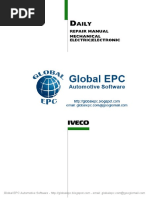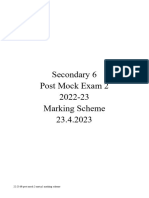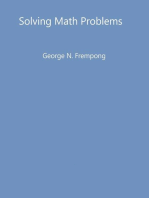2019 Mock-MATHS-CP-1-MS
Uploaded by
angelayingying12242019 Mock-MATHS-CP-1-MS
Uploaded by
angelayingying1224MATHEMATICS Compulsory Part 2019 PAPER 1 Marking Scheme
Section A(1)
( x 4 y 5 )3 x 12 y15
1. = 1M
( y 3 )2 y 6
y15 6
= 1M
x12
y 21
= 1A
x12
............ (3)
2. 5(a – 4b) = 3a + 2
5a – 20b = 3a + 2 1M
2a = 20b + 2 1M for putting a
on one side
a = 10b + 1 1A
............ (3)
3. (a) 6m2 + 7mn – 5n2 = (3m + 5n)(2m – n) 1A
(b) 6m + 7mn – 5n – 10m + 5n = (3m + 5n)(2m – n) – 10m + 5n
2 2
1M for using the
result of (a)
= (3m + 5n)(2m – n) – 5(2m – n)
= (2m – n)(3m + 5n – 5) 1A
............ (3)
2 for numerator
4. The required probability = 1M + 1M
(3)(4) for denominator
2
=
12
1
= 1A
6
............ (3)
5. (a) Selling price = $9300 × (1 – 35%) 1M
= $6045 1A
(b) Let $x be the cost of the mobile phone.
x(1 + 50%) = 9300 1M
x = 6200
∵ Cost = $6200 > $6045
∴ There will be a loss after selling the mobile phone. 1A f.t.
............ (4)
1 © Educational Publishing House Ltd
5 x 46
6. (a) 2(3x – 1)
3
5x + 46 18x – 6
for putting x
5x – 18x –6 – 46 1M
on one side
–13x –52
x 4 1A
(b) 32 – 4x > 0
x<8 1A
By (a), we have 4 x < 8
∴ The required integers are 4, 5, 6 and 7. 1A
............ (4)
7. (a) Let f (x) = ax + bx2, where a and b are non-zero constants. 1A
f (8) = 16
8a + 82b = 16
a + 8b = 2 ...... (1) 1M
f (–4) = –56 either one
–4a + (–4) b = –56
2
a – 4b = 14 ...... (2)
Solving (1) and (2), we have
a = 10, b = –1
∴ f (x) = 10x – x2 1A
(b) f (x) = –24
10x – x2 = –24
x2 – 10x – 24 = 0 1M
(x + 2)(x – 12) = 0
x = –2 or 12 1A
............ (5)
8. (a) Median = 1 1A
(b) (i) Angle of sector for 2 credit cards = 360 – 135 – 60 – x
= 165 – x 1M
Mean = 1.5
0(60) 1(135) 2(165 x) 3x
= 1.5 1M
360
x = 75 1A
(ii) The required number = 24 1A
............ (5)
2 © Educational Publishing House Ltd
9. (a) Let l cm be the length of OA.
216
πl 2 = 1215 1M
360
l2 = 2025
l = 45
∴ The length of OA is 45 cm. 1A
(b) Let r cm and h cm be the base radius and the height of the circular cone respectively.
r(45) = 1215 1M
r = 27
h = 452 27 2
= 36
1
Capacity of the vessel = π (27)2 (36) cm3 1M
3
= 8748 cm3 1A
............ (5)
Section A(2)
10. Join AD.
∵ AC BC
∴ AB is a diameter of the circle ACBD. (converse of in semi-circle) 1M
BDC = BAC (s in the same segment) 1M
= 35 either one
ADB = 90 ( in semi-circle) 1M
ADC + 35 = 90
ADC = 55
∵ AC = CD (given)
∴ CAD = ADC (base s, isos. △) 1M
BAD + 35 = 55
BAD = 20
BCD = BAD (s in the same segment)
= 20 1A
............ (5)
3 © Educational Publishing House Ltd
11. (a) Let p(x) = (ax + b)(2x2 + 8x – 5), where a and b are constants. 1M
By the remainder theorem,
p(1) = –5
[a(1) + b][2(1) + 8(1) – 5] = –5
2
a + b = –1 …… (1) 1M
p(–2) = 91 either one
[a(–2) + b][2(–2) + 8(–2) – 5] = 91
2
–2a + b = –7 …… (2)
Solving (1) and (2), we have
a = 2, b = –3
The required quotient is 2x – 3. 1A
............ (3)
(b) p(x) = 0
(2x – 3)(2x + 8x – 5) = 0
2
2x – 3 = 0 or 2x2 + 8x – 5 = 0
82 – 4(2)(–5) 1M
= 104
>0
∴ 2x2 + 8x – 5 = 0 has two distinct real roots. 1M
3
Also, is a real root of p(x).
2
∴ The claim is agreed. 1A f.t.
............ (3)
12. (a) (i) Г is parallel to L1. 1A
0 12
(ii) Slope of L1 = 1M
16 0
3
= 1A
4
16 2
x-intercept of Г =
2
= –7 1A
The equation of Г:
3
y–0= [x – (–7)]
4
3x – 4y + 21 = 0 1A
............ (5)
4 © Educational Publishing House Ltd
21
(b) y-intercept of Г =
4
21 2
Distance between the intercepts of Г = (7 0)2 (0 )
4
35
=
4
1 21
(7)( )
The shortest distance from Г to O = 2 4 1M
1 35
( )
2 4
= 4.2
>4
∴ There is no point Q lying on Г such that the distance
between the origin O and Q is less than 4. 1A
............ (2)
13. (a) ABE = 90 given
ECD = 180 – 90 int. s, AB // DC
= 90
∴ ABE = ECD
BAE + ABE + AEB = 180 sum of △
BAE + 90 + AEB = 180
BAE = 90 – AEB
CED + AED + AEB = 180 adj. s on st. line
CED + 90 + AEB = 180
CED = 90 – AEB
∴ BAE = CED
AEB = EDC sum of △
∴ △ABE ~ △ECD AAA
Marking Scheme:
Case 1 Any correct proof with correct reasons. 2
Case 2 Any correct proof without reasons. 1
............ (2)
(b) Let BE = x cm. Then EC = (13 – x) cm. 1M
AB BE
= (corr. sides, ~△s) 1M
EC CD
10 x
=
13 x k
x – 13x + 10k = 0 ...... (*)
2
5 © Educational Publishing House Ltd
of (*) 0 1M
(–13) – 4(1)(10k) 0
2
169
k
40
∴ The greatest value of k is 4. 1
(4 10)(13)
The greatest area of the trapezium ABCD = cm2 1M
2
= 91 cm2
∴ It is not possible that the area of the trapezium ABCD is greater than 92 cm2. 1A f.t.
............ (6)
14. (a) 65 – (50 + x) = 13 1M
x=2 1A
............ (2)
(b) (i) (70 + z) – (40 + y) > 36 1M
z–y>6
40 y 44 50(2) 52(2) 54 56 57 58
59(2) 61 62 65(2) 68 73 75 70 z
= 59 1M
20
y + z = 10
y = 1, z = 9 1A
(ii) Let a kg and b kg be the weights of these two students, where a b.
a b 59(20)
= 59 + 1 1M
22
a + b = 140 …… (*)
Original range = 79 – 41 = 38
New range = 38 + 1 = 39
Case 1: a = 40, 40 b 79 1M
a + b 40 + 79 either one
= 119
< 140
∴ It is not possible.
Case 2: 41 < a 80, b = 80
By (*), a + 80 = 140
a = 60
∴ The weights of these two students are 60 kg and 80 kg. 1A + 1A
............ (7)
6 © Educational Publishing House Ltd
Section B
C34
15. (a) The required probability = 1 1M
C39
20
= 1A
21
............ (2)
C33 C23C151
(b) The required probability = 1M
C39
19
= 1A
84
............ (2)
16. (a) Put = 28 – 3 into = –2 + 5 + 12.
28 – 3 = –2 + 5 + 12 1M
2 – 8 + 16 = 0
=4
= 28 – 3(4)
= 16 1A Both correct
............ (2)
(b) 1st term = log 4 = 2 log 2
Common difference = log 16 – log 4 1M
= 4 log 2 – 2 log 2
= 2 log 2
n[2(2log 2) 2(n 1)log 2]
< 777 1M
2
(log 2)n2 + (log 2)n – 777 < 0
–51.307 362 92 < n < 50.307 362 95 1M
∴ The greatest value of n is 50. 1A
............ (4)
7 © Educational Publishing House Ltd
17. (a) Let I be the incentre of △ABC.
1
Area of △ABI = ar
2
1
Area of △BCI = br
2
1
Area of △ACI = cr
2
1 1 1
Area of △ABC = ar br cr 1M
2 2 2
abc
= r
2
= sr
By Heron’s formula,
Area of △ABC = s( s a)( s b)( s c) 1M
sr = s( s a)( s b)( s c)
(s a)(s b)(s c)
r= 1
s
............ (3)
(b) Let (h, r) be the incentre of the △OPQ.
OP = (8 0)2 (15 0)2 = 17
OQ = 28
PQ = (8 28)2 (15 0)2 = 25
By using (a),
17 28 25
s= = 35
2
(35 17)(35 28)(35 25)
r= 1M
35
=6
(17 – h) + (28 – h) = 25 1M
h = 10
The equation of inscribed circle:
(x – 10)2 + (y – 6)2 = 62 (or x2 + y2 – 20x – 12y + 100 = 0) 1A
............ (6)
8 © Educational Publishing House Ltd
18. (a) In △ABC,
h
BC = m 1M
tan 40
either one
In △ABD,
h
BD = m
tan ADB
In △BCD, by the sine formula,
BC BD
= 1M
sin 29 sin 53
h h
tan 40 = tan ADB
sin 29 sin 53
tan 40 sin 29
tan ADB =
sin 53
ADB 26.993 076 99
= 27.0, cor. to 3 sig. fig. 1A
............ (3)
(b) Let Q be the foot of perpendicular from B to CD.
BQ = BC sin 53
h sin 53
= m
tan 40
AB
tan AQB =
BQ
h
tan AQB =
h sin 53
tan 40
AQB 46.415 339 83 1M
AB
Note that tan APB = and AB is a constant.
BP
Also, BP BQ 1M
tan APB varies inversely as BP. 1M
∴ APB increases from ACB (40) to AQB (46.4)
and then decreases to ADB (27.0). 1A
............ (4)
9 © Educational Publishing House Ltd
1 2
19. (a) f (6) = [6 + (4k – 12)6 – 6k + 36]
k
1
= (18k)
k
= 18 1
∴ The graph of f (x) passes through F.
............ (1)
1 2
(b) (i) f (x) = [x + (4k – 12)x – 6k + 36]
k
1 2
= [x + 2(2k – 6)x + (2k – 6)2 – (2k – 6)2 – 6k + 36] 1M
k
1 1
= [x + (2k – 6)]2 + [–(2k – 6)2 – 6k + 36]
k k
1
= (x + 2k – 6)2 – 4k + 18
k
g(x) = f (–x) – 12 1M
1
= (–x + 2k – 6)2 – 4k + 18 – 12
k
1
(x – 2k + 6)2 – 4k + 6
= 1M
k
∴ Coordinates of U = (2k – 6, –4k + 6) 1A
(ii) Note that the circumference of the circle passing through F and
O is the least when FO is a diameter of the circle. 1M
FUO = 90
(4k 6) 0 (4k 6) 18
= –1 1M + 1A
(2k 6) 0 (2k 6) 6
2k 3 2k 6
k 3 k 6 = –1
4k2 + 6k – 18 = –k2 + 9k – 18
5k2 – 3k = 0
3
k= or 0 (rejected) 1A
5
(iii) Coordinates of G = (–6, 6) 1A
6 0 6 18
Slope of GO × slope of GF = 1M
6 0 6 6
= –1
FGO = FVO = 90
∴ F, G, O and V are concyclic. 1A f.t.
............ (11)
10 © Educational Publishing House Ltd
You might also like
- Automatic Street Light Control System Using IOTppt90% (10)Automatic Street Light Control System Using IOTppt21 pages
- Mock 2019 Compulsory Part Paper 1 SolutionsNo ratings yetMock 2019 Compulsory Part Paper 1 Solutions15 pages
- Mock 2018 Compulsory Part Paper 1 SolutionsNo ratings yetMock 2018 Compulsory Part Paper 1 Solutions14 pages
- Ufs8XYVT7J1BnFaYHcwg F3 2324 Second Term Mock Solution Ver4.5 4.1No ratings yetUfs8XYVT7J1BnFaYHcwg F3 2324 Second Term Mock Solution Ver4.5 4.120 pages
- 24-25 中六數學 Pre Mock 卷一 (題目) - ENG - 答案 (學生版)No ratings yet24-25 中六數學 Pre Mock 卷一 (題目) - ENG - 答案 (學生版)18 pages
- 2022-2023 S4 Paper 1 2nd Term Exam Marking SchemeNo ratings yet2022-2023 S4 Paper 1 2nd Term Exam Marking Scheme5 pages
- 2021-22 Math Core Post Mock Exam Paper 1 Marking SchemeNo ratings yet2021-22 Math Core Post Mock Exam Paper 1 Marking Scheme16 pages
- S1_Q02_Basic-Algebra-and-Number-Pattern_Ver2024_Quiz_solutionNo ratings yetS1_Q02_Basic-Algebra-and-Number-Pattern_Ver2024_Quiz_solution3 pages
- Pearson_ 2024 Compulsory Part Paper 1 Marking_ENo ratings yetPearson_ 2024 Compulsory Part Paper 1 Marking_E8 pages
- Maths (Paper I) Marking Scheme & Suggested Solution (English Version)No ratings yetMaths (Paper I) Marking Scheme & Suggested Solution (English Version)13 pages
- 18-19 f.4 Yearly Exam Paper 1 SolutionsNo ratings yet18-19 f.4 Yearly Exam Paper 1 Solutions14 pages
- F6-MATHS-1-FINAL(2022-2023)(SOLUTION).pdf 的副本No ratings yetF6-MATHS-1-FINAL(2022-2023)(SOLUTION).pdf 的副本11 pages
- Y X y X: Compulsory Part Paper 1 Solution MarksNo ratings yetY X y X: Compulsory Part Paper 1 Solution Marks16 pages
- 2024-2025 MockExam S6 Maths (Core)P1 (SectionA Solution)No ratings yet2024-2025 MockExam S6 Maths (Core)P1 (SectionA Solution)15 pages
- 2020 2021 - F.4 First Term ExamMath CP 1 - AnsNo ratings yet2020 2021 - F.4 First Term ExamMath CP 1 - Ans9 pages
- 2021-22 S6 Exam Mock Exam Paper 1 (English) (Tak Oi Maths) (Solutions)No ratings yet2021-22 S6 Exam Mock Exam Paper 1 (English) (Tak Oi Maths) (Solutions)9 pages
- Trigonometric Ratios to Transformations (Trigonometry) Mathematics E-Book For Public ExamsFrom EverandTrigonometric Ratios to Transformations (Trigonometry) Mathematics E-Book For Public Exams5/5 (1)
- 10+2 Level Mathematics For All Exams GMAT, GRE, CAT, SAT, ACT, IIT JEE, WBJEE, ISI, CMI, RMO, INMO, KVPY Etc.From Everand10+2 Level Mathematics For All Exams GMAT, GRE, CAT, SAT, ACT, IIT JEE, WBJEE, ISI, CMI, RMO, INMO, KVPY Etc.No ratings yet
- Introductory Chapter: New Challenges and Innovations in Grape and Wine ProductionNo ratings yetIntroductory Chapter: New Challenges and Innovations in Grape and Wine Production8 pages
- Zero and 1st Conditionals Grammar ExercisesNo ratings yetZero and 1st Conditionals Grammar Exercises2 pages
- Method Statement For Fire Alarm System Installation100% (1)Method Statement For Fire Alarm System Installation4 pages
- Whole Unit 2 - Crude Oil and Refining Product TestingNo ratings yetWhole Unit 2 - Crude Oil and Refining Product Testing113 pages
- Systemized Orthodontic Treatment Mechanics100% (1)Systemized Orthodontic Treatment Mechanics312 pages
- Automatic Street Light Control System Using IOTpptAutomatic Street Light Control System Using IOTppt
- Ufs8XYVT7J1BnFaYHcwg F3 2324 Second Term Mock Solution Ver4.5 4.1Ufs8XYVT7J1BnFaYHcwg F3 2324 Second Term Mock Solution Ver4.5 4.1
- 2021-22 Math Core Post Mock Exam Paper 1 Marking Scheme2021-22 Math Core Post Mock Exam Paper 1 Marking Scheme
- S1_Q02_Basic-Algebra-and-Number-Pattern_Ver2024_Quiz_solutionS1_Q02_Basic-Algebra-and-Number-Pattern_Ver2024_Quiz_solution
- Maths (Paper I) Marking Scheme & Suggested Solution (English Version)Maths (Paper I) Marking Scheme & Suggested Solution (English Version)
- 2024-2025 MockExam S6 Maths (Core)P1 (SectionA Solution)2024-2025 MockExam S6 Maths (Core)P1 (SectionA Solution)
- 2021-22 S6 Exam Mock Exam Paper 1 (English) (Tak Oi Maths) (Solutions)2021-22 S6 Exam Mock Exam Paper 1 (English) (Tak Oi Maths) (Solutions)
- Trigonometric Ratios to Transformations (Trigonometry) Mathematics E-Book For Public ExamsFrom EverandTrigonometric Ratios to Transformations (Trigonometry) Mathematics E-Book For Public Exams
- 10+2 Level Mathematics For All Exams GMAT, GRE, CAT, SAT, ACT, IIT JEE, WBJEE, ISI, CMI, RMO, INMO, KVPY Etc.From Everand10+2 Level Mathematics For All Exams GMAT, GRE, CAT, SAT, ACT, IIT JEE, WBJEE, ISI, CMI, RMO, INMO, KVPY Etc.
- Introductory Chapter: New Challenges and Innovations in Grape and Wine ProductionIntroductory Chapter: New Challenges and Innovations in Grape and Wine Production
- Method Statement For Fire Alarm System InstallationMethod Statement For Fire Alarm System Installation
- Whole Unit 2 - Crude Oil and Refining Product TestingWhole Unit 2 - Crude Oil and Refining Product Testing

























































































